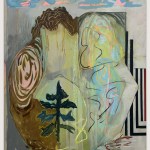
Contributed by Paul Laster / Creating playful paintings with psychological twists, Clayton Schiff makes his 56 Henry exhibition debut with the solo show Small World, featuring five medium-scale canvases (all from 2019 and 2020) that depict cartoon-like characters in poetic realms. A 2009 RISD BFA grad, Schiff has been gaining momentum and well-deserved attention in two-person outings and group shows at galleries in Brooklyn, Los Angeles and Stockholm over the past few years.


Equally influenced by the modest, muted still life paintings of Giorgio Morandi and the childrens book illustrations of Dr. Seuss, Schiff stages surreal visual narratives with anthropomorphic figures in sparse, dreamlike settings. A doodler since he was a kid, the New York-based artist works from small notebook sketches, which he brings to fuller realization in the process of painting.


Elongated, animal-like figures grip stone pine trees as they shyly hide from and enviously surveil a more confident character strolling down a path in the painting Keeping Up. Wearing socks with sandals, the nerdish fellow strides forward with a contained sense of nervousness. The painting could be a reflection of the artists time in college, when he spent a semester in Rome, where stone pinesor umbrella pines, as they are commonly calledare prevalent, or it could be where his thoughts are now, as he pines for more with his peers watching.

Accommodations also portrays a person on a pathway, but this time the guy is on a long and winding road that tunnels through a reclining sphinx. Although the mythological creature has legs, and thus could move, it didnt. The route, which society has constructed, cruelly cuts right through the beast rather than going around it. The formal structure of the painting is quite crafty, too. The distant, puffy clouds get repeated as pattern in the sphinxs modeled coat and the curving, yellow trail, which conjures thoughts of the fanciful road that wound through the Land of Oz, splits the pale pink landscape into two superfluous pieces of an impenetrable puzzle.
Focused on the harsh realities of urban life, Schiffs Crummy City canvas captures a nude humanoid figure bringing home groceries or supplies, as peculiar roaming pets couple in the street. The blue, Gumby-like man passes a green wall hiding a construction site as he proceeds toward a generic, pale blue residential building with two bags in hand. Along the wall, a plant sprouting from a crack wilts, while on the barrier a poster begins to peel, symbolic of the decay that continues to take place even as the metropolis welcomes the new.
City life is also the subject of the painting Connecting, where we find a man with a dogs head daydreaming on a park bench. Appearing to be lost in thought, the figure clothes are twisted and wrinkled around his arms and legs, as he anxiously grips the outdoor seating. His furrowed forehead is echoed in the imaginary web thats projected in front of his fiery, red head. A tangle of neural pathways that are clinging to a nearby tree, taking root in the sickly yellow ground and beginning to entwine the man, the web becomes everything that the character needs to be confronting being considered all at once, which is definitely worrisome.
Finally, in the lastand most gruesomecanvas in the concise hanging, Returned turns illness into a corporeal meltdown. The neural pathways of the neck and mind are again transformed into interconnected roots as a decomposing, wrinkled head fades into the earth. Plants and flowers grow out of a gaping hole in its cheek and dissolved nose, while rats feed on the rotting remains. Like Dutch vanitas of old, the painting delivers a powerful punch, even if its rendered in a style thats more reminiscent of the famed Playboy cartoonist Gahan Wilson.
Further formal features of the work that should be noted are the contrasting colors, which provide a push-pull effect between the more vibrant tones and the artists dominant pastel palette, and the feathered edges of the pigmented picture on the canvas, which reminds us that this is just a slice of life, not the full course.
“Clayton Schiff: Small World,” 56 Henry, 56 Henry Street, New York, NY. Through January 17, 2021.
About the author: Paul Laster is a writer, editor, curator, artist, and lecturer. He is a contributing editor at ArtAsiaPacific and Whitehot Magazine of Contemporary Art.
Related posts:
The Great War and Modernism
Fred Valentine: I make pictures
Sly and witty: Female Surrealists in Los Angeles






















